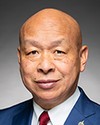Yes, I do. We've had that conversation before. Thank you, Chair.
I'm going to make some introductory remarks as the shadow minister for hunting, fishing and conservation in His Majesty's loyal opposition. Then I'll get to some of the questions I have for our esteemed witnesses.
Canada was once a refuge for a rugged individual, and we would be hard-pressed to make a case for that in Canada today. Since 1850, urbanization has swept the country, practically inverting the population of urban dwellers and rural residents. Today, nearly 80% of Canadians live in an urban area. As noted by one of the members opposite, Canada has changed.
Although he's not entirely wrong in his assessment, in this process of change, many aspects of this country have been improved; however, blind nostalgia does us no favours.
As different as the country looks today compared to the one the traveller would have found in 1850, this does not mean that all traces of this old Canada ought to be erased. For those Canadians and first nations who live in remote areas or participate in the outdoor way of life, their lived reality is different from that of those who live in the most populated parts of our nation.
As you can imagine, life in places like Pond Inlet in Nunavut; Ignace, Ontario; Sept-Îles, Quebec; Corner Brook, Newfoundland; or Prince Rupert, British Columbia, resemble nothing of the urban experience in downtown Vancouver, Toronto or Montreal. One should note that the prevalence of firearms licences per 100 people is the highest in Yukon, with a rate of 19.17%. One in five Yukoners has a firearm. This compares to the national average of just under 6%, thus indicating a wide swing in licence ownership in certain parts of the country.
It may come as a surprise to the members opposite, but those participating in the hunting lifestyle are surprisingly diverse. The hunters of today are not your trappers of the early fur trade, which, by the way, is an essential part of our history and the basis of modern commerce in our nation. Hunting is a genuine family-oriented activity, enjoyed by those of all creeds and ethnic backgrounds, and in it the wisdom of past generations is passed down to the new.
I am here at committee today because, with Bill C-21, the federal government has, whether it wants to admit it or not, basically said to hunters that their way of life is going to be no more.
Guns are not weapons of war, as some politicians would like to have you believe, but an essential harvesting tool used for hunters to feed their families. It provides food security in our northern and remote communities. I've heard scoffing and other rhetoric from other politicians indicating that this way of life is not even needed in a modern Canada.
I take particular offence to what appears to be the carelessness of the drafting of not only this bill but of the proposed amendments that are before it. It is clear to me that Bill C-21 is not based on science at all. It is not based on any evidence at all; it is a simple, political decision. The problem with this is that it tarnishes the time-honoured traditions of firearms owners and sport shooters in this country, hunters included. It sullies the reputations of these good, honest, law-abiding, patriotic Canadians.
The philosopher Jean-Jacques Rousseau, a proponent of naturalism, once stated that the only true freedom was found in nature alone and that one must remain close to nature and its inherent liberty and equality. It is Rousseau who created the concept of the social contract to counter the loss of freedom brought on by man's move away from the inherent freedom of nature. He believed that a man's participation in what he called unnatural collective activities infringed on his liberty and, as such, a bargain called a social contract had to be struck.
The purpose of the social contract made by sacrificing some individual freedom for state protection and co-operative benefits lays out the obligations of government towards its subjects.
Although we could argue about what these consist of, John Locke, another contributor to the theory of social contracts, explained it best when he said, “...being all equal and independent, no one ought to harm another in his Life, Health, Liberty or Possessions”.
Bill C-21 is a piece of legislation that breaks this social contract. Beyond the obvious point of liberty, it also infringes on both the right to possess guns themselves and a right to personal health and freedom.
This may all seem academic, but fear not. I'm about to present some real-world, concrete examples of what the infringement on the Canadian social contract means for the hunting community.
Canadians have a reasonable right to own their possessions. One of the foundational pillars of the social contract, private property, lies at the heart of many democratic systems.
We know this to be true, as even though it is not enshrined in our legislation, Canada is a signatory to the 1948 Universal Declaration of Human Rights, which recognizes that everyone “has the right to own property” and provides that no one shall be “arbitrarily deprived” of his or her property. “Arbitrarily” is an important word in this context, as Bill C-21 does it exactly this way.
Not only is the classification of firearms in amendments G-4 and G-46 arbitrary, but the lack of buyback or any provisions hinting at a buyback is also proof of how little the government regards the concept of property rights.
It is also striking to me that many of these guns included on the list of firearms are not solely semi-automatic, as intended by the legislation and as advertised by the Prime Minister; many are bolt-action rifles and shotguns, including the likes of the Winchester model 54, the Weatherby Mark V, the Kimber 89 African and the Montana Rifle 1999. These are not military rifles that later became popular as hunting arms; they were designed explicitly for the purpose of hunting.
A separate point I would like to make is the availability of both firearms and ammunition in northern communities. Access to firearms in northern communities is already limited, and they can be hard to come by in the make and model desired by hunters. Notwithstanding COVID-19 supply chain issues, there has been a long-running difficulty in supplying the north with these items. In fact, Canada Post will no longer ship ammunition. Now, with this proposed ban, if it comes into force, replacing these banned firearms will be difficult for first nations and Inuit in an already stretched market.
By instituting such a wide-ranging ban, the Liberal government will make if difficult for these hunters to replace their firearms, yet these people are the most likely to perform sustenance hunting. This ban will endanger a critical method of ensuring food security in a harsh environment, where groceries come at an irregular pace and with high prices.
Lastly, I would like to focus on how our new gun laws will affect the tourism sector. Hunters inbound from abroad, especially the United States, contribute significantly to our hunting sector and keep our lodges and outfitters busy. I might add that for the last two years of COVID-19, guides and outfitters in lodges have been some of the hardest hit in the tourism sector.
I can tell you, as a hunter, that these tourists often prefer to take their own firearms, as they will not only be more ergonomic but also have the added safety benefit of the hunter knowing his own firearm. Depriving foreign tourists of their reasonable hunting rifles, as proposed—I can assure you it will happen with the evergreen clause, as it's referred to—with the scheduled list of firearms will result in yet another blow to the guides, outfitters and lodges across our country.
As for the health component of the social contract, it is clearly violated by Bill C-21. Those closest to the natural world—for example, our rural Canadians and hunters—are the most impacted by the loss of liberty engendered by an increasingly urbanized society. They are also the ones most vulnerable to the loss of their physical well-being due to the prohibition of their tools and property.
As previously mentioned, this bill may, in fact, affect food security. There is also a physical health component to the firearms debate that is not often discussed, which is that of workers in remote areas. In some parts of our country and in some industries, firearms are vital to one's physical safety. In this scenario, firearms are used for self-defence. Tour operators operating in the north need to ensure that their guests are protected from polar bears and other wildlife. They have a duty of care to protect their guests.
When beekeepers go out into remote areas to collect honey from their hives, it is not at all uncommon for a beekeeper to be caught unaware by a lingering bear. This is a completely different scenario from a hunter who is walking through the woods, carrying his or her firearm, ready at a moment's notice to pursue the hunt. These are people who find themselves in a defensive position. These are people who need to be able to react and respond quickly, because their primary focus and objective while they're working is not the same as the primary focus of somebody who is hunting.
I can tell you without any hesitation whatsoever that the ability to have a shotgun that would be caught up in the evergreening clause or on the schedule that is proposed in these amendments to Bill C-21 would take a vast number of firearms away from people who are just trying to defend themselves. I know beekeepers who carry with them a Tavor because it is compact, it has five rounds, it is chambered in .308 and it will stop a bear.
Now this beekeeper is going to have his property rendered valueless and he has to go and search for another firearm or shotgun that would have similar capabilities to the Tavor, not knowing if amendment G-4 to this proposed legislation, the amendment coming through, would in fact would eventually get that new firearm caught up in the prohibited list.
This violates the social contract between Canadians and their government, and it also potentially harms the health, safety and well-being of Canadians.
I remember very vividly, because I have worked most of my life prior to coming to Parliament in the outdoor industry. I was a conservation officer with the Province of Alberta and I was a national park warden in Jasper National Park. I'm also a hunter.
There are numerous reasons people would have a semi-automatic firearm. Anybody working in the forestry industry, anybody who has done the job of timber cruising where you are going down a cut line determining whether or not a cut block is going to be productive or not for your forestry company, would carry with them a shotgun likely advertised by the manufacturer as a defender. It could be semi-automatic. It could be pump action. It would likely have a pistol grip and it would likely be polymer plastic or made out of polymer and it would be black.
It would look to the untrained eye like a scary gun, but it is the firearm that would be best used and best positioned to provide the safety benefit to somebody's son or daughter, to somebody's brother or sister, to somebody's mom or dad who is working in the outdoor environment in a situation where they could be put at risk, not to mention all of the hunters in this land.
Not everybody who hunts does so with a firearm. There are bowhunters. If you don't have the knowledge or experience of what it's like to sit in a tree stand and call or bugle for an elk or for a buck or for a bull moose, what you are also doing in that act is letting every predator in the woods know that you are there as well. It is not unreasonable at all for a bow hunter to have a safety firearm with them. It needs to be small and compact; otherwise, it does not work in that scenario.
Numerous firearms that are newly added to the list in the proposed amendments will now render firearms that were bought specifically for the purpose of personal protection by people, either through their work or through their enjoyment of hunting, useless if not worthless. Their property will be rendered useless if not worthless.











